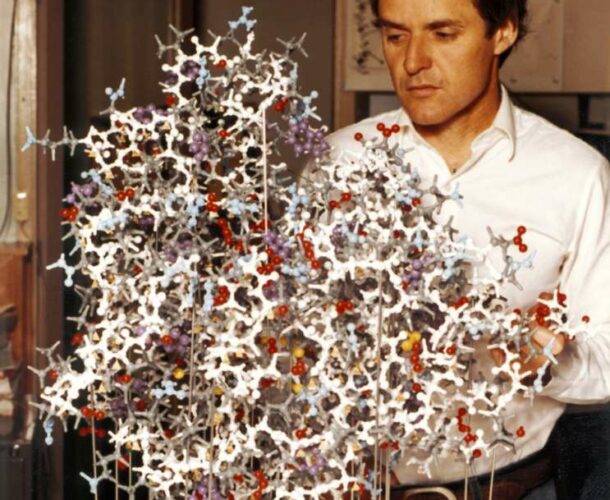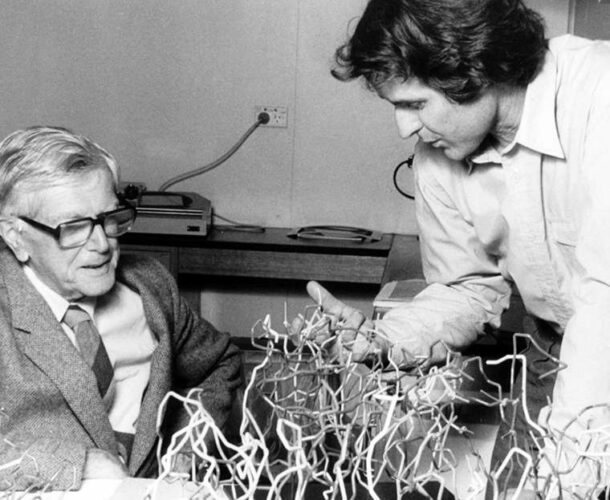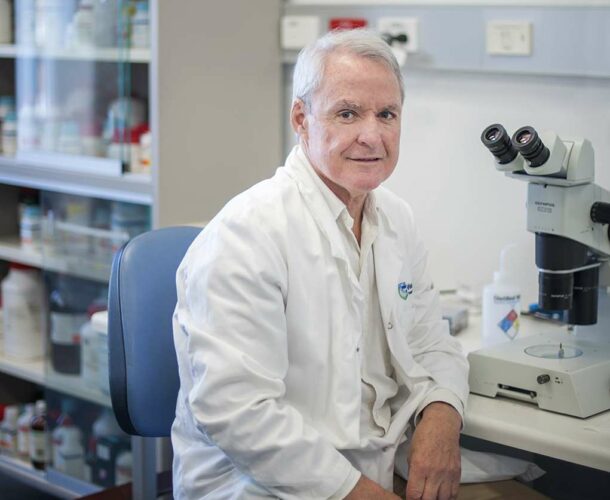In 1996, Professor Peter Colman joins the institute to establish a structural biology division.
A powerful new approach
As a student at the University of Adelaide in the 1960s, Professor Peter Colman fell under the influence of the charismatic Harry Medlin, an unlikely physicist, decorated veteran, former commando and Japanese prisoner of war, who had taken up his studies after the war. His passion was x-ray crystallography, and he excited his student to think about how he might enlist the discipline to explore the life sciences.
“I was fascinated by the power of that approach – you could learn so much about anything by crystallising it.” Sending x-rays through the crystal could reveal the mysterious way atoms interact with each other, revealing the structures of a molecule.
By applying the technique to living proteins, “you end up with a very detailed picture of what the protein is,” says Colman. “Just like taking the back off a mechanical watch can teach you how it is working, if you can see a protein molecule in all its fine atomic detail you can work out how it is doing, what it is doing, understand its role in living processes.”
Insights yielded by this approach, 20 years later when he was working at CSIRO, underwrote Colman’s pivotal contribution to the discovery of anti-influenza drugs.
Examining crystals to flu breakthrough
It began when he started examining crystals an Australian National University scientist, Dr Graeme Laver, had grown from a protein from the virus. The trouble with influenza is that the proteins are always changing, so the antibodies that worked against last season’s flu won’t work against it the next time it comes around.
“I wanted to see if there was any method in the madness of the whole thing,” Colman recalls. Might there be any clues in the structure, nooks and crannies acquired in its previous manifestations, to predict what next year’s influenza virus would look like?” By using crystallography to assemble the three-dimensional structure of this protein, he found something else – a vulnerability that could be exploited, a target site that never changed.
By designing a compound that would fit into that site, like a piece into a jigsaw puzzle, the protein’s ability to replicate itself would be obstructed, stopping it in its tracks. The result of that breakthrough consumers know today as Relenza and Tamiflu, drugs stockpiled by governments in anticipation of the next pandemic. Relenza is among the first drugs designed directly to exploit knowledge of a protein structure.
A radical notion
In 2000 Colman was leading the Biomolecular Research Institute in Parkville, set up as a collaboration by CSIRO and the Victorian Government. When its funding was withdrawn, then Walter and Eliza Hall Institute director, Professor Suzanne Cory, saw an opportunity to acquire expertise she was convinced the institute needed to remain an elite, world-class player.
She hired Colman and 25 others of his team, establishing the Structural Biology division. In a sense it returned to the institute some of its heritage. Influenza had been a big preoccupation of its work in the 1930s and 1940s.
“One of the things that attracted me here was the idea that this protein Bcl-2, whose function in keeping cells alive had been discovered in the late 1980s by PhD student David Vaux, might be useful in making drugs to kill cancers,” says Colman.
It was a radical notion. “The way many cancer drugs work is that they set off a chain reaction inside the cell, the end point of which is that the cell detects that it is stressed or damaged by the drugs and then the suicide switch inside the cell gets flicked and it dies. The Bcl-2 protein sits right at that switch point … Putting your finger on the suicide switch seems to be a pretty dangerous thing to be doing. No-one quite knew what would happen.
“So we ended up doing all the things we had done with flu and more – using x-ray crystallography to take photographs of the protein, and to take photographs of the molecules that bound weakly to the protein, and then imagine how you could make them stronger, make changes. A big team of chemists and biologists are now involved in this, in collaboration with some drug companies in the US.”
A leap of faith
And so, “15 years later there are molecules going into patients in late-stage clinical trials that are targeting that protein and are indeed bringing some patients into remission”.
For now the application is focused on chronic lymphocytic leukemia. But “I think there is hope it might be useful in other circumstances too – we will have to wait and see”.
Cory took a leap of faith, Colman says, in recruiting him and others – structural biologists and chemists who can make molecules. But today they are an integral part of the operation, working with researchers exploring how their work might find its way into a drug discovery program.
“Has it been a success? It might be too soon to know. But from my own rather embedded view of it, there are signs it is being successful.”
Colman is encouraged too by the opportunities he sees present director, Professor Doug Hilton, creating at the Walter and Eliza Hall Institute for the next generation of scientists. There’s the same excitement and spirit in the new recruits that Harry Medlin stirred in him. “And that is where the next big ideas come from, the young ones.”




